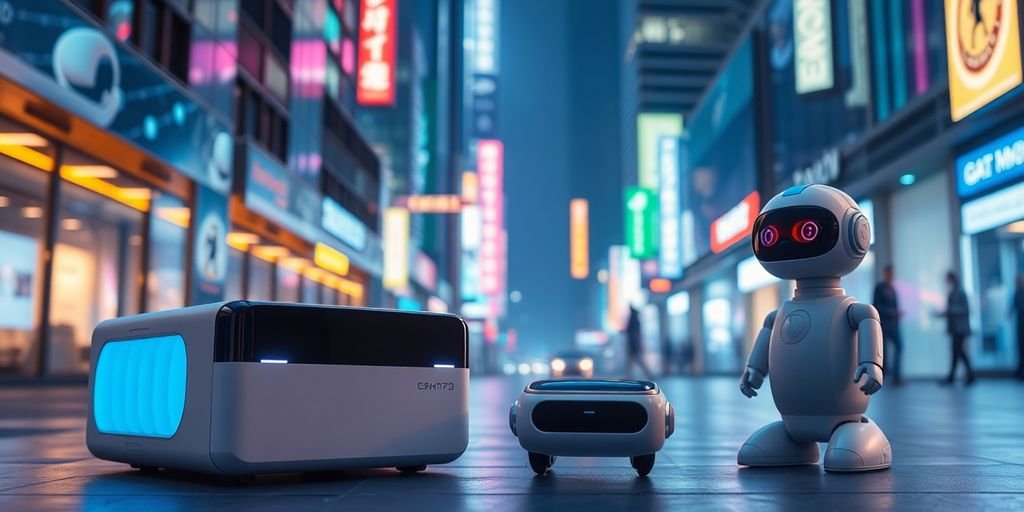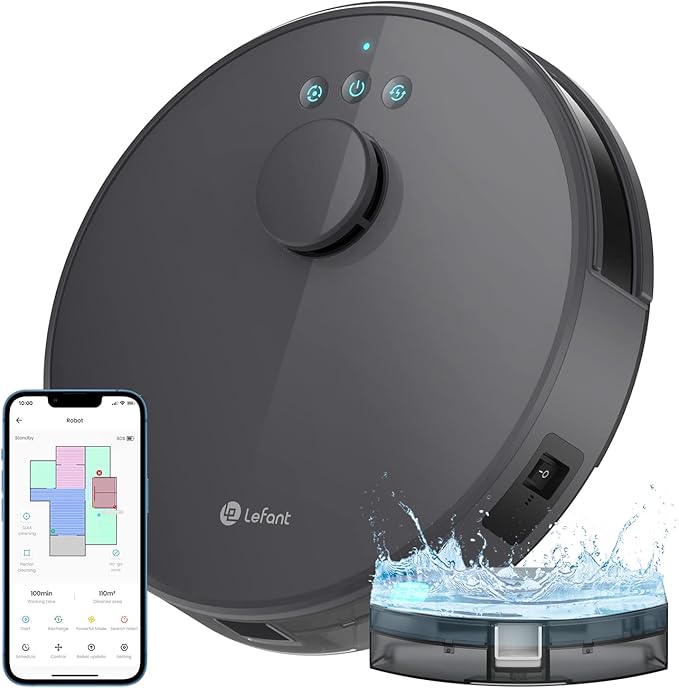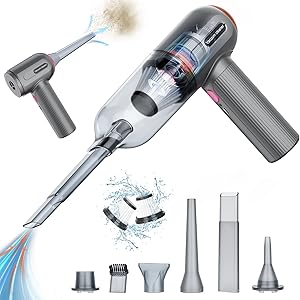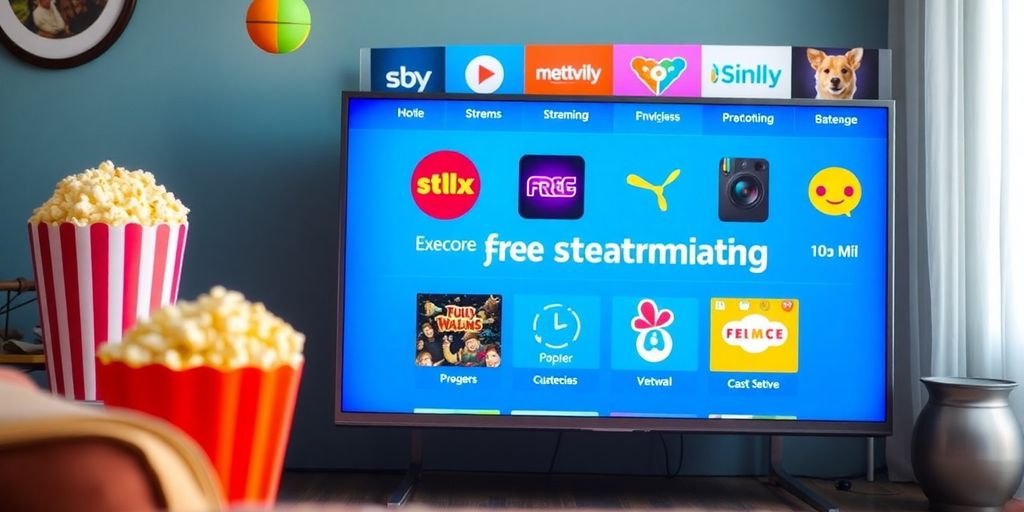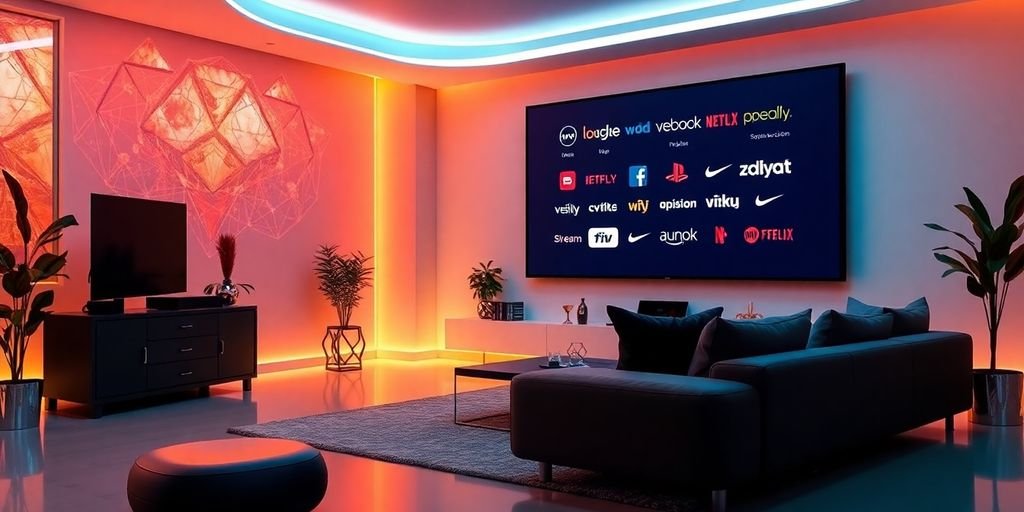As we look ahead to 2025, a wave of futuristic gadgets is set to transform our daily lives in ways we can only begin to imagine. From advanced wearables that monitor our health to smart home devices that adapt to our needs, the innovations on the horizon promise to make our lives easier and more connected. In this article, we will explore some of the most exciting and innovative gadgets that are expected to make a splash in 2025.
Key Takeaways
- Futuristic gadgets are transforming everyday health monitoring with smart health devices.
- Home automation is becoming more intuitive with AI-driven assistants and energy-efficient appliances.
- Personal robotics are set to enhance our lives, from cleaning to cooking.
- Transportation innovations, including flying cars and hyperloop systems, are on the cusp of becoming a reality.
- Communication devices are evolving, featuring holographic displays and brain-computer interfaces.
Revolutionary Wearable Technology

Wearable tech has come a long way, hasn’t it? What started as simple fitness trackers has morphed into something almost unrecognisable. In 2025, we’re seeing wearables that are not just functional, but also incredibly stylish and integrated into our daily lives. It’s less about clunky gadgets and more about seamless technology that enhances our experiences.
Smart Health Monitors
These aren’t your average step counters. We’re talking about devices that can monitor everything from your heart rate and blood pressure to even your blood sugar levels in real-time. The data is then fed into sophisticated AI algorithms that can provide personalised insights and even alert you to potential health issues before they become serious. Imagine getting a notification on your watch telling you to take it easy because your stress levels are spiking – that’s the kind of proactive health management we’re looking at. It’s like having a doctor on your wrist, constantly keeping an eye on things.
Augmented Reality Glasses
Forget the clunky AR glasses of the past. The new generation is sleek, lightweight, and actually, dare I say it, fashionable. These glasses overlay digital information onto your real-world view, providing hands-free access to maps, notifications, and even entertainment. Imagine walking down the street and seeing restaurant reviews pop up as you pass by, or getting step-by-step directions overlaid onto your path. It’s like having a personal assistant right in front of your eyes. Meta’s Ray-Ban smart glasses are a good example of the direction things are heading.
Adaptive Clothing
This is where things get really interesting. Adaptive clothing uses smart fabrics and sensors to respond to your body’s needs and the environment around you.
Here are some examples:
- Self-regulating temperature: Clothing that can automatically adjust to keep you comfortable, whether it’s hot or cold.
- Posture correction: Garments that gently nudge you into better posture, reducing back pain and improving your overall health.
- Impact protection: Clothes that can stiffen on impact, providing extra protection during sports or other activities.
It’s all about creating clothing that is not just something you wear, but something that actively enhances your well-being and performance. It’s a fusion of fashion and technology that has the potential to revolutionise the way we think about what we wear.
Next-Generation Home Automation

Home automation is getting a serious upgrade in 2025. It’s not just about turning your lights on with your phone anymore; we’re talking about systems that learn your habits, anticipate your needs, and generally make your life easier. Think of it as having a digital butler, but without the awkward small talk.
AI-Driven Smart Assistants
These aren’t your average voice assistants. We’re moving beyond simple commands to AI that can actually understand context and learn from your behaviour. Imagine an assistant that not only reminds you about appointments but also pre-heats the oven based on your usual dinner time, or adjusts the thermostat based on weather forecasts and your personal preferences. It’s about creating a truly intuitive and responsive home environment. The best smart home devices are becoming more integrated with AI.
Integrated Security Systems
Security is a major focus, with systems that go far beyond basic alarms. We’re seeing facial recognition technology, advanced motion sensors, and even AI that can detect unusual activity and alert the authorities. It’s like having a 24/7 security guard, but one that never sleeps and doesn’t need coffee breaks. These systems can also integrate with other smart home devices, like automatically locking doors and turning on lights if something seems amiss.
Energy-Efficient Appliances
Sustainability is key, and home automation is playing a big role. New appliances are designed to minimise energy consumption, with features like smart thermostats that learn your heating and cooling patterns, and washing machines that optimise water usage based on the load size.
It’s all about creating a home that’s not only comfortable and convenient but also environmentally friendly. These systems can even track your energy usage and provide insights on how to reduce your carbon footprint. It’s a win-win for your wallet and the planet.
Here’s a quick look at potential energy savings:
| Appliance | Potential Savings (%) |
|---|---|
| Smart Thermostat | 15-20 |
| Smart Lighting | 25-30 |
| Smart Washing Machine | 10-15 |
- Smart plugs that cut off power to devices when they’re not in use.
- Automated blinds that adjust based on sunlight to regulate temperature.
- Water leak detection systems that can automatically shut off the water supply to prevent damage.
Advanced Personal Robotics
The future is here, and it’s got wheels, arms, and maybe even a charming personality. Personal robotics is moving beyond simple vacuum cleaners; we’re talking about robots that can genuinely assist with daily life. It’s not just about convenience; it’s about enhancing our capabilities and freeing up our time. The advancements in AI and machine learning are making these robots more adaptable and useful than ever before.
Companion Robots
Imagine having a robot that’s not just a machine, but a friend. Companion robots are designed to provide emotional support, engage in conversation, and even offer reminders for appointments or medications. These robots are becoming increasingly sophisticated, capable of recognising faces, understanding emotions, and adapting their behaviour to suit individual needs. They’re particularly beneficial for the elderly or those living alone, offering a sense of connection and reducing feelings of isolation. The ethical considerations around emotional dependence are being discussed, but the potential benefits are undeniable.
Home Cleaning Drones
Tired of chores? Home cleaning drones are here to help. These aren’t your average robot vacuums; we’re talking about autonomous flying devices that can dust shelves, clean windows, and even tidy up clutter. Equipped with advanced sensors and AI, they can navigate your home with ease, avoiding obstacles and efficiently cleaning every nook and cranny.
- Autonomous navigation.
- Object recognition.
- Scheduled cleaning routines.
The integration of these drones into our homes raises questions about privacy and data security, but the convenience they offer is hard to ignore.
Personal Chef Robots
Say goodbye to meal prep stress with personal chef robots. These advanced machines can prepare a wide range of dishes, from simple snacks to gourmet meals. They can follow recipes, adjust ingredients to your dietary needs, and even clean up after themselves. With the rise of AI-powered cooking assistants, healthy and delicious meals are now just a voice command away. These robots are revolutionising restaurants by cooking and serving food. Meanwhile, aged care facilities are experimenting with humanoid robots to address labour shortages and meet the demands of ageing populations. In 2025, I expect multiple announcements of aged care facilities that will be predominantly operated by humanoid robots.
| Feature | Description |
|---|---|
| Recipe Database | Access to thousands of recipes, with regular updates. |
| Dietary Customisation | Ability to adjust recipes based on allergies, preferences, and health goals. |
| Automated Cleaning | Self-cleaning functionality for minimal maintenance. |
Innovative Transportation Solutions
It’s wild to think about how much transport is changing. Seems like every other day there’s some new crazy idea popping up. From self-driving cars to things that fly, it’s a proper revolution, innit?
Autonomous Electric Vehicles
Right, so self-driving cars. They’re not just a pipe dream anymore. We’re seeing proper progress with electric vehicles that can drive themselves. The idea is to make roads safer, cut down on traffic, and, of course, be kinder to the planet. I saw one the other day, and it was a bit eerie, not gonna lie, seeing a car with no one actually driving. But if it means fewer accidents, I’m all for it. The integration of IoT technology is also helping to improve traffic flow.
Hyperloop Technology
Okay, this one still feels like something out of a sci-fi film. The hyperloop is basically a super-fast train that travels in a tube. The idea is that it could get you from London to Edinburgh in like, what, 30 minutes? It’s all still in the works, but if they can pull it off, it would be a game-changer. Imagine skipping all those airport queues! Here’s a quick look at potential speeds:
| Route | Current Time | Hyperloop Time (Est.) |
|---|---|---|
| London to Paris | 2h 15m | 30m |
| London to Edinb | 4h 30m | 45m |
| London to NY | 7h 30m | 1h 30m |
Flying Cars
Flying cars! I mean, come on, who hasn’t dreamed of these? They’re not quite like the ones in The Jetsons just yet, but there are companies working on personal aircraft that could take off and land vertically. Imagine skipping the M25 traffic jams altogether. It’s a bit bonkers, but also pretty exciting. I wonder if they’ll need special driving licences? I’d probably crash it on day one.
The future of transport is looking pretty wild. It’s not just about getting from A to B anymore; it’s about doing it faster, cleaner, and maybe even in the air. Whether it’s self-driving cars, hyperloops, or flying cars, the next few years are going to be interesting, that’s for sure.
Here’s a quick list of things to consider:
- Safety regulations need to catch up.
- Infrastructure will need a massive overhaul.
- The cost needs to come down before any of this becomes mainstream.
Cutting-Edge Communication Devices
Communication is changing fast, and 2025 is bringing some wild new gadgets to the table. Forget just calling and texting; we’re talking about completely different ways to connect with each other. It’s a bit like science fiction becoming reality, and honestly, it’s pretty exciting to see where things are headed.
Holographic Displays
Holographic displays are getting seriously good. Imagine being able to have a face-to-face conversation with someone who’s actually miles away, their image projected right in front of you. The tech is still a bit bulky, but the clarity and realism are improving all the time. I saw a demo the other day, and it felt like I was actually in the same room as the person. It’s not just for calls either; think about gaming, presentations, or even just displaying art in your home. The possibilities are pretty much endless.
Brain-Computer Interfaces
Okay, this one sounds like something straight out of a movie, but brain-computer interfaces (BCIs) are becoming more of a thing. The idea is to control devices with your mind. Early versions are already helping people with paralysis to communicate and move prosthetic limbs. But the future? Well, some people reckon we’ll all be using BCIs to control our phones, computers, and even our cars. It’s a bit scary to think about, but also pretty amazing. There are ethical considerations, of course, but the potential benefits are huge.
Wearable Translation Devices
Language barriers could soon be a thing of the past thanks to wearable translation devices. These little gadgets can instantly translate spoken language in real-time. You could be chatting with someone who speaks a completely different language, and you’d both understand each other perfectly. It’s not just about holidays either; think about business meetings, international collaborations, or even just making new friends from different cultures. It could make the world a much smaller, more connected place.
These communication devices are not just about making things easier; they’re about changing the way we interact with each other and the world around us. It’s a brave new world, and it’s going to be interesting to see how it all unfolds.
Sustainable Energy Gadgets
It’s 2025, and the push for sustainable living is stronger than ever. Gadgets powered by clean energy are no longer a niche; they’re becoming mainstream. We’re seeing some seriously cool innovations that are changing how we think about power and consumption. Businesses are starting to show environmental commitment and a competitive advantage, as organisations embrace these innovations.
Solar-Powered Chargers
Forget scrambling for a plug socket. Solar-powered chargers have had a major glow-up. They’re more efficient, more compact, and way more stylish. You can get everything from phone chargers to laptop power banks that soak up the sun’s rays. I saw one the other day that could fully charge a laptop in about 4 hours – pretty impressive, right? These are great for outdoor use, especially the solar oven.
Energy Harvesting Devices
This is where things get really interesting. We’re talking about gadgets that can pull energy from all sorts of unexpected places. Think kinetic energy from walking, thermal energy from body heat, even radio waves floating around in the air. It sounds like science fiction, but it’s happening. Imagine a jacket that charges your phone just from you moving around – that’s the kind of thing we’re seeing.
Here are some examples of energy harvesting:
- Piezoelectric harvesters (converting mechanical stress into electricity)
- Thermoelectric generators (converting temperature differences into electricity)
- Electromagnetic harvesters (converting electromagnetic radiation into electricity)
Smart Grids
Smart grids are the brains behind a sustainable energy future. They use AI and advanced sensors to manage energy distribution more efficiently. This means less waste, better reliability, and the ability to integrate renewable energy sources more seamlessly. It’s like having a super-smart traffic controller for the power grid, making sure everything flows smoothly and efficiently. Renewable energy technicians are needed to maintain these green energy technologies.
Immersive Entertainment Technologies
Entertainment is about to get a whole lot more interesting. Forget just watching a screen; in 2025, it’s all about experiencing the action. We’re talking tech that blurs the line between what’s real and what’s not, offering levels of immersion we could only dream of a few years ago.
Virtual Reality Experiences
VR is no longer just a gimmick. It’s becoming a mainstream way to game, learn, and even socialise. New headsets are lighter, more powerful, and easier to use. Think about exploring ancient ruins from your living room or attending a concert with friends who are miles away. The possibilities are pretty wild. The improvements in display resolutions and motion tracking are making the experiences more realistic and less likely to cause motion sickness, which is a big win for everyone.
Mixed Reality Gaming
Imagine playing a strategy game where the battlefield is your kitchen table, or battling dragons that burst through your living room wall. That’s the promise of mixed reality gaming. It blends the digital and physical worlds, creating experiences that are both engaging and interactive.
AI-Generated Content
AI is changing how content is made. We’re seeing AI tools that can create music, write stories, and even design entire game worlds. This means more personalised entertainment experiences, with content tailored to your tastes. It also means that anyone can become a creator, regardless of their technical skills. It’s a bit scary, but also pretty exciting.
The rise of AI-generated content raises some interesting questions about creativity and ownership. Who owns a song written by an AI? Can an AI be considered an artist? These are questions we’ll need to answer as this technology becomes more prevalent.
Final Thoughts on the Gadgets of Tomorrow
As we wrap up our look at the most exciting gadgets of 2025, it’s clear that technology is racing ahead at a breakneck pace. From smart wearables that keep us connected to AI devices that make our lives easier, these innovations are set to change the way we live and work. Sure, some of these gadgets might seem a bit out there right now, but that’s the beauty of tech—it’s always evolving. Who knows what the next big thing will be? One thing’s for sure: staying curious and open to new ideas will help us make the most of what’s coming. So, keep your eyes peeled and your mind open; the future is just around the corner!
Frequently Asked Questions
What are some examples of wearable technology in 2025?
In 2025, wearable technology includes smart health monitors that track your vital signs, augmented reality glasses that enhance your view of the world, and adaptive clothing that adjusts to your body temperature.
How do AI-driven smart assistants work?
AI-driven smart assistants use artificial intelligence to understand your commands and help you manage tasks at home, like controlling lights or setting reminders.
What is the purpose of companion robots?
Companion robots are designed to provide company and support, helping people feel less lonely and assisting with daily tasks.
Are flying cars available in 2025?
Yes, in 2025, flying cars are being developed and tested, aiming to reduce traffic on the roads and provide faster travel options.
How do holographic displays enhance communication?
Holographic displays create 3D images that can be viewed without special glasses, making video calls and presentations more engaging and lifelike.
What is the role of solar-powered chargers?
Solar-powered chargers harness sunlight to charge devices, promoting renewable energy use and reducing dependence on traditional power sources.

